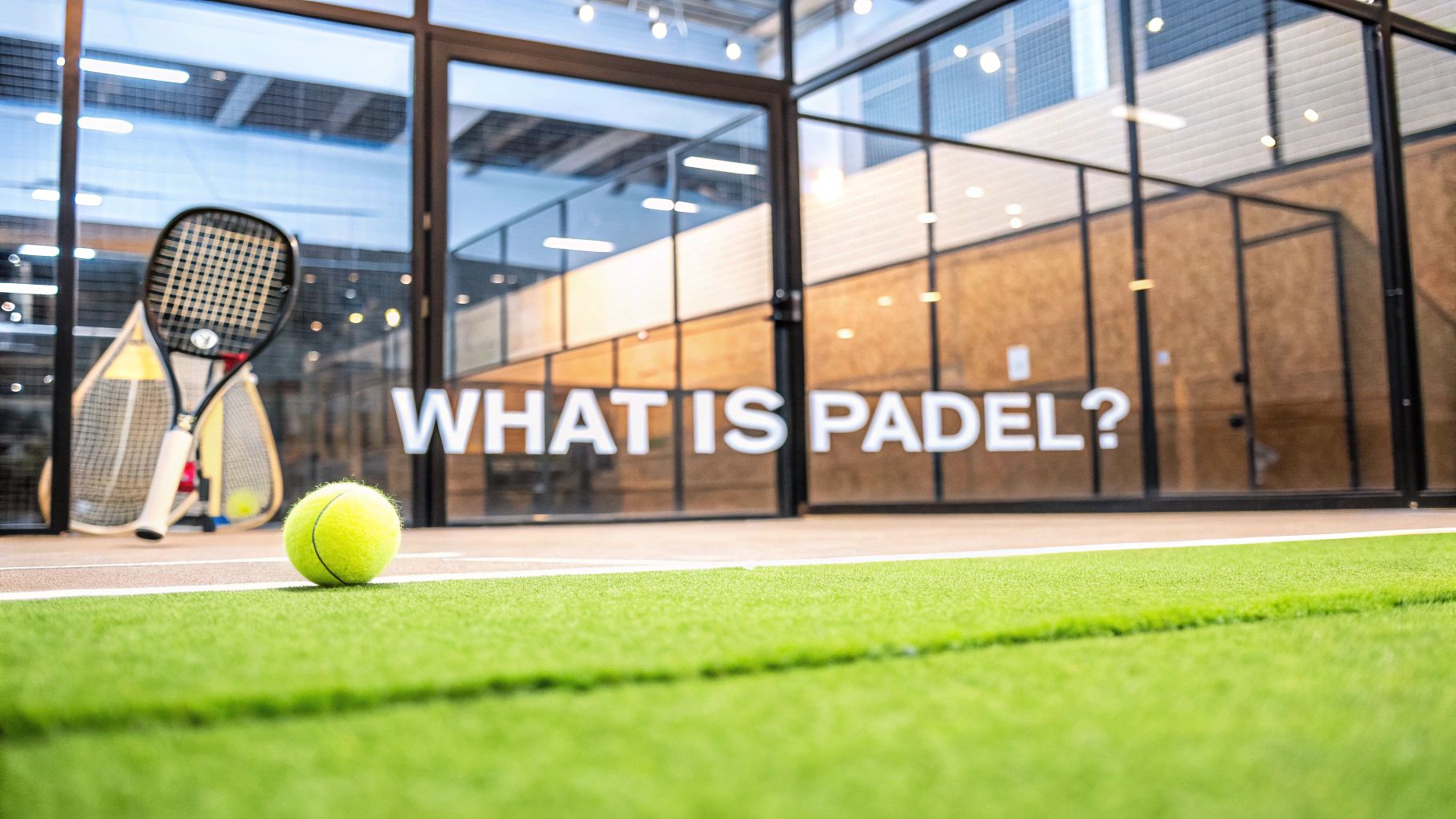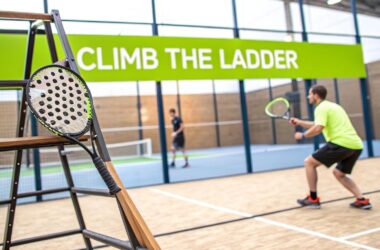If you’ve heard a buzz about a new racket sport taking over your local club, chances are it’s padel. So, what exactly is it? Think of it as a brilliant mix of tennis and squash, played entirely in doubles on a court that's smaller than a tennis court and enclosed by glass walls.
The Ultimate Guide to Padel
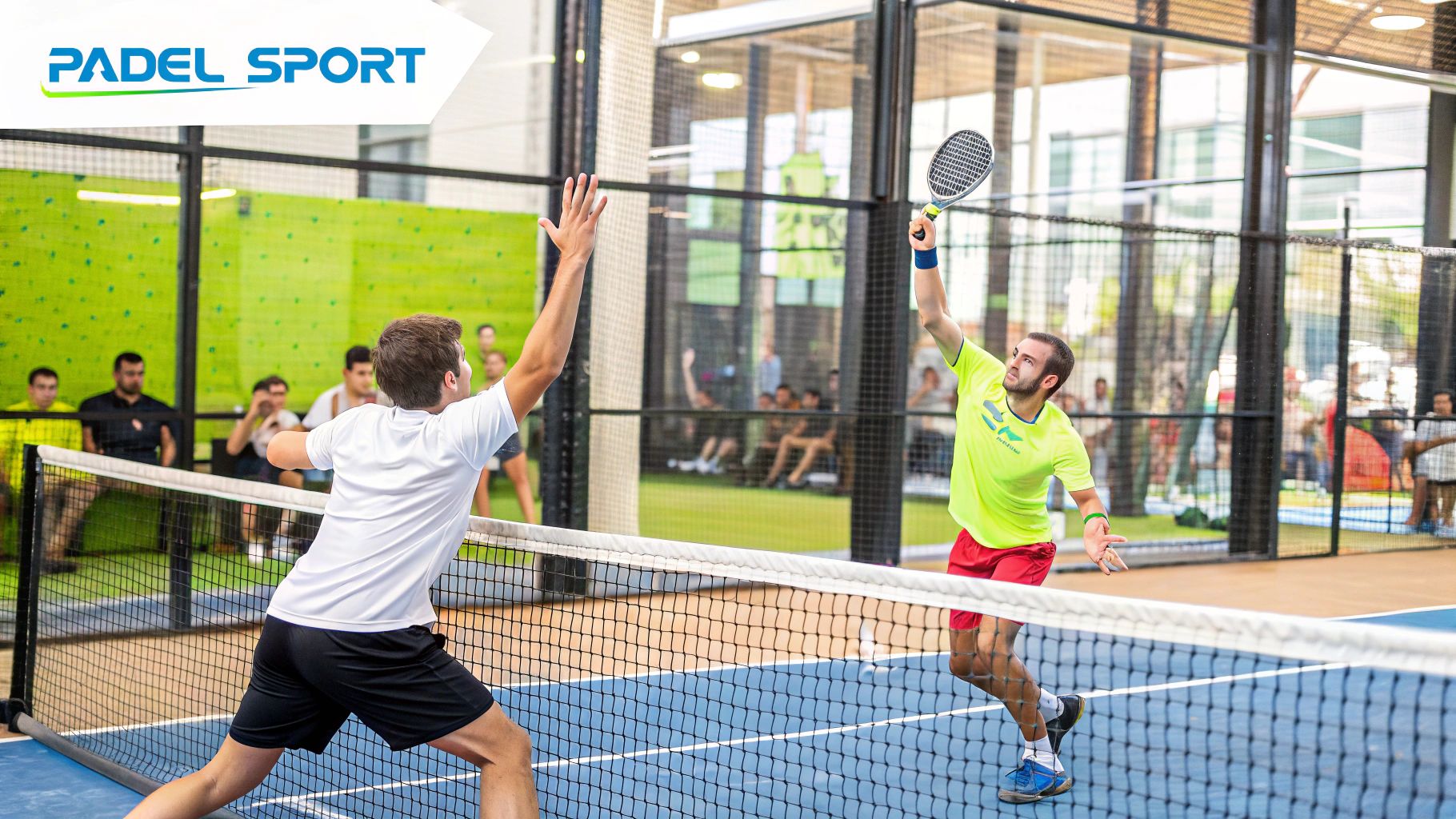
It’s easy to see why everyone’s falling in love with it. Imagine a tennis rally, but now you can use the walls to your advantage, just like in squash. This simple but game-changing rule creates longer, more dynamic rallies and introduces a whole new layer of strategy. The walls aren't just boundaries; they're your teammates.
What really sets padel apart, though, is how incredibly welcoming it is for newcomers. Forget the steep learning curve of other racket sports. The serve is a gentle underhand bounce, and the smaller court means you don't have to be a track star to cover it. This perfect combo means that even absolute beginners can get a fun rally going in their very first session.

Buy the best padel gear to level up your next game!
CHECK OUT this deal from Padel Market!Get ready to take your game to the next level with the latest padel gear from Padel Market! Fast EU and Worldwide Shipping
A Quick Look at Padel's Core Elements
Before we dive deeper, here's a simple breakdown of what makes padel, well, padel.
Padel at a Glance
| Component | Description |
|---|---|
| Court | A 10 x 20-meter rectangle enclosed by glass and mesh walls, which are part of the playing area. |
| Players | Always played in doubles (two vs. two), making it a very social sport. |
| Racket | A solid, stringless paddle (the "pala") with holes, which is shorter and easier to handle than a tennis racket. |
| Ball | Looks like a tennis ball but has slightly less pressure, making it a bit slower and less bouncy. |
| Scoring | Identical to tennis scoring (15, 30, 40, game). |
| Serve | Must be underhand, with the ball bounced once before being hit below waist level. |
This table gives you the basics, but the real magic happens when you step onto the court and experience how these elements work together.
It's a True Global Phenomenon
Padel isn't just a fleeting trend—it's one of the fastest-growing sports on the entire planet. Its growth has been nothing short of explosive, spreading like wildfire from its strongholds in Spain and Argentina to become a worldwide sensation.
The numbers are staggering. The sport is now played on over 70,000 courts across nearly 150 countries. To put that in perspective, that's up from just 21,000 courts a few years ago. This boom is fueled by a global player base that has swelled to over 30 million people. As you can see on sites like MiamiPremierPadel.com, this isn't just growth; it's an explosion.
Padel's magic lies in its perfect balance: it’s simple enough for anyone to learn quickly, yet offers enough strategic depth to challenge even the most seasoned athletes. It’s a sport built for fun, fitness, and social connection.
This unique combination of an easy start and a high skill ceiling is exactly why everyone, from families looking for a weekend activity to professional athletes, is picking up a padel racket. It’s a game that promises instant fun and keeps you hooked for the long run.
The Court and Equipment You Need to Play
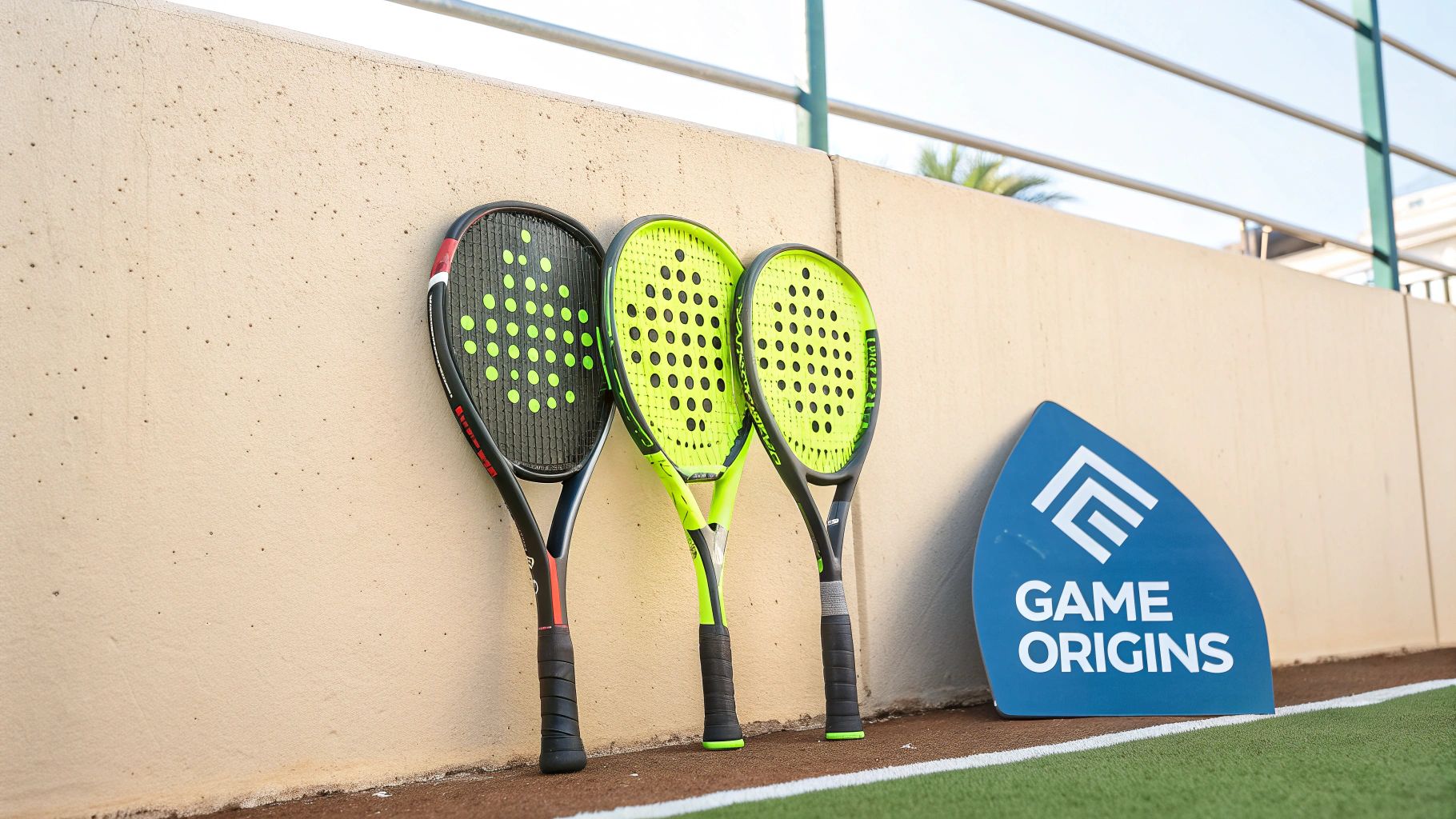
To really get a feel for what padel is all about, you have to understand its unique playing environment and the gear that goes with it. Unlike a lot of sports where the equipment feels like a slight tweak on something you've seen before, padel's tools are totally distinct. They're built from the ground up for its lightning-fast, strategic gameplay.
It all starts with the court.
A padel court is a compact, 20×10 meter rectangle, which is a good bit smaller than a tennis court. That smaller size is actually a huge part of the sport's appeal, as it means less ground to cover. But the real game-changer is the enclosure—the court is surrounded by walls, usually glass at the back and sides, with wire mesh filling in the rest.
These walls aren’t just there to keep the ball in. They're an active part of the game. Just like in squash, you can play the ball after it bounces off the glass walls, which leads to some incredible rallies and forces you to think differently. A shot that would be a mile out in tennis could be the perfect setup for a return in padel. If you're curious about how these venues are built, you can dig deeper into the specifics of modern padel courts and their construction.
The Padel Racket or Pala
Next up, the racket, which is known as a "pala". The first thing you'll notice is that it has no strings. It’s a solid, perforated paddle, typically made from materials like carbon fiber or fiberglass with a foam core. This design is all about giving you an amazing level of control.
- Easy to Handle: The pala is much shorter and more maneuverable than a tennis racket, which makes it incredibly easy for beginners to start making solid contact with the ball.
- Superior Control: Its solid face gives you a great feel for the ball, letting you place your shots with precision and add some wicked spin.
- Perforated Surface: Those holes in the racket face aren't just for looks. They cut down on air resistance, making it lighter to swing while adding a bit of extra "bite" to your shots.
This blend of features makes the pala feel like a natural extension of your arm. It really helps flatten the learning curve and gives new players a ton of confidence right away.
The genius of padel equipment is its focus on control over raw power. The stringless racket and low-compression ball are designed to slow the game down just enough, promoting longer rallies and smarter, more tactical play.
The Padel Ball and Proper Footwear
Finally, the ball itself is tailor-made for the sport. While it looks almost identical to a tennis ball, a padel ball has slightly less internal pressure. That tiny change makes a world of difference on the court.
This lower pressure means the ball bounces a little less and travels a little slower, giving you more time to react and line up your next shot. It's a deliberate design choice that perfectly complements the smaller court and wall-play, leading to the long, exciting rallies that make the game so addictive.

Buy the best padel gear to level up your next game!
CHECK OUT this deal from Padel Market!Get ready to take your game to the next level with the latest padel gear from Padel Market! Fast EU and Worldwide Shipping
Pair that with the right footwear—you'll want shoes with excellent grip for all the quick side-to-side movements—and you've got everything you need to hit the court and discover what makes this sport so amazing.
Understanding the Fundamental Rules of Padel
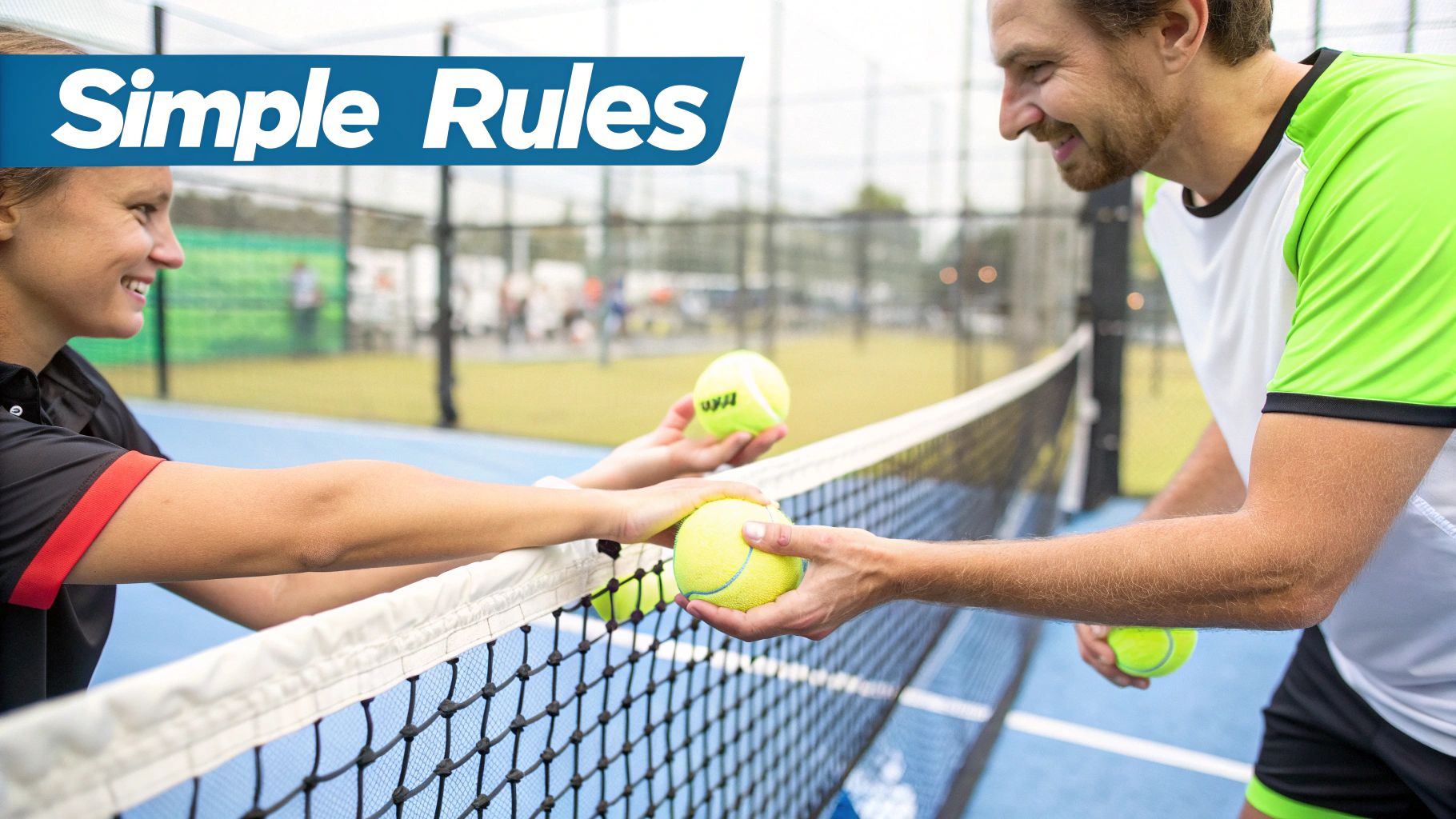
Jumping into a new sport can feel a bit intimidating, but the good news is that padel’s rules are refreshingly simple. They're designed to get you playing and having fun almost immediately. Forget about a thick, complicated rulebook; the core mechanics are easy to pick up, starting with a serve that’s far more welcoming than in other racket sports.
The serve is your first real taste of padel's accessible nature. Unlike the powerful, over-the-head serves you see in tennis, a padel serve is always underhand. The process is a breeze: stand behind the service line, let the ball bounce once, and then hit it below your waist, aiming diagonally into your opponent's service box.
This simple "bounce-then-hit" motion removes a huge hurdle for beginners. It means rallies kick off with control rather than raw power, letting players get into a proper point from the very first shot. Just like in tennis, you get two chances to land a legal serve.
Keeping Score Is Simple
If you’ve ever watched or played tennis, you’re in luck—you already know how to keep score in padel. The scoring system is identical, which makes tracking the game feel instantly familiar. It’s one less thing to worry about, so you can focus on hitting the ball.
Points are counted in the same classic sequence:
- First point: 15
- Second point: 30
- Third point: 40
- Fourth point: Game
To win a set, a team must be the first to win six games, but they have to win by a two-game margin. If the score hits 6-6, a tie-break is usually played to decide the set. This familiar structure makes padel incredibly easy to follow, whether you're on the court or just watching.
Mastering the Art of the Walls
This is where padel truly comes alive and shows its unique personality. The glass walls enclosing the court aren’t just boundaries; they're an active part of the game. Once you learn how to use them, what might seem like a lost point can become a brilliant strategic move.
Here’s the basic rule: the ball must hit the ground on your opponent's side once before it touches a wall. After that first bounce, you can let the ball rebound off one or even multiple walls before you hit it back. You can even play the ball off your own back wall to return a tricky shot. This opens up a whole new world of creative shots and leads to longer, more dynamic rallies.
For a complete breakdown of every rule and regulation, you can check out our deep dive on the official rules of padel.
The essence of padel strategy isn't just about hitting the ball hard; it's about understanding angles and using the walls to outmaneuver your opponents. A soft, well-placed rebound can be far more effective than a powerful smash.
This exciting dynamic is a huge reason for the sport’s explosion in popularity. The international competition scene is booming, with the number of tournaments nearly doubling in a single year from 71 to 132 events. This staggering 86% increase shows just how fast organized play is growing to meet demand, with over 3,200 elite athletes from 91 different countries now competing professionally.
Once you know these three things—the underhand serve, the tennis-style scoring, and how to use the walls—you have everything you need to get on a court and have a fantastic time. It's this simple yet strategic foundation that makes padel one of the most exciting and social sports you can play.
Comparing Padel vs Tennis: Key Differences
For a lot of newcomers, the quickest way to get a feel for padel is to stack it up against its closest cousin, tennis. They might share a net and a scoring system, but the on-court experience couldn't be more different. Just thinking of padel as "mini-tennis" really sells short the unique strategic depth that makes the game so addictive.
The most glaring difference is the court itself. A padel court is smaller and completely enclosed by glass walls, which aren't just boundaries—they're a core part of the game. In tennis, if a shot gets past you, the point is over. In padel, a ball bouncing off the back wall is your lifeline, a golden opportunity to reset and launch a counter-attack. This single feature completely changes the game's rhythm, leading to longer, more exciting rallies.
This image really captures the essential gear that creates the unique padel experience.
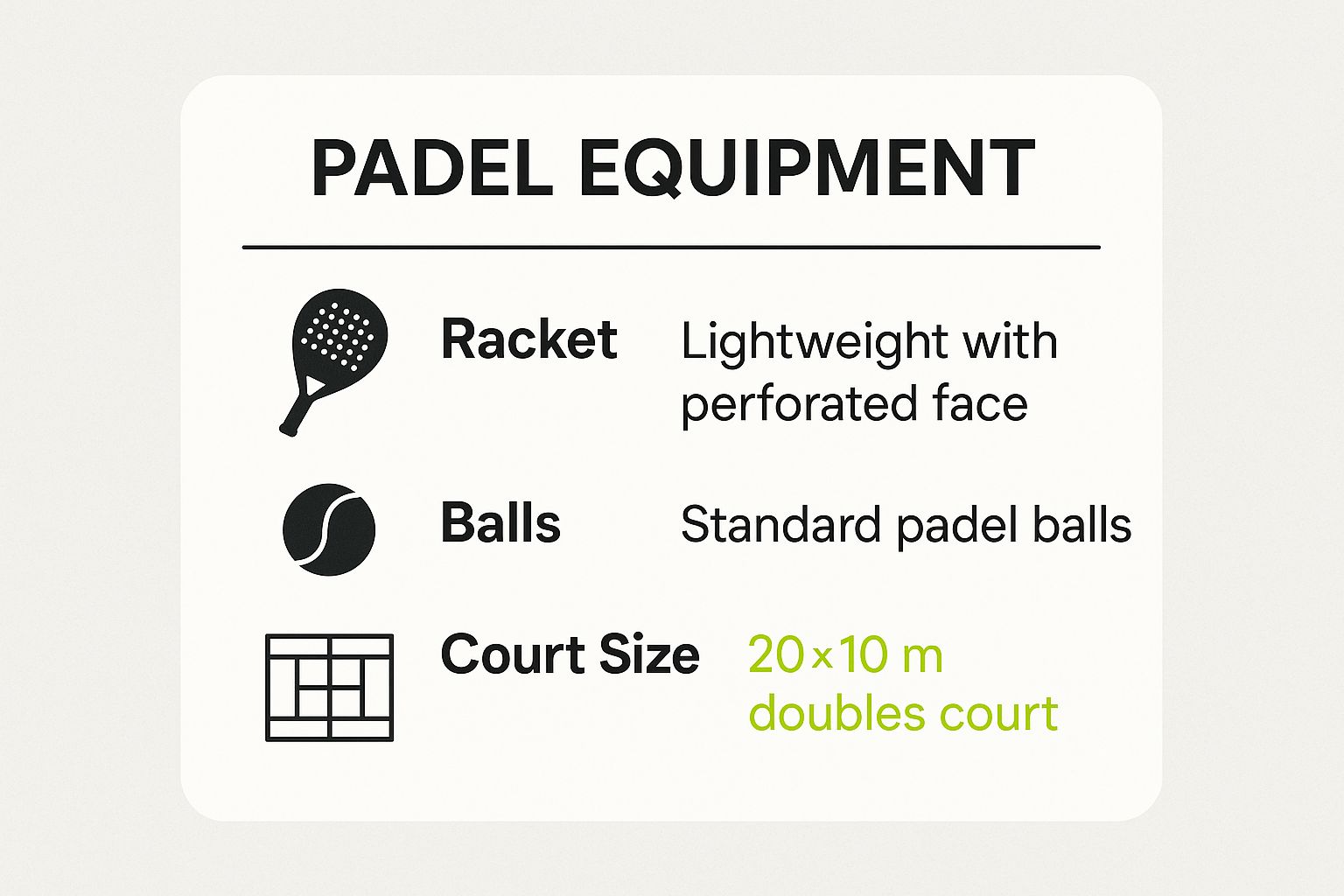
All of these elements—the solid racket, the specific balls, and the compact court—are designed to work together, shifting the focus from brute power to smart strategy and pinpoint control.
Serve And Racket Dynamics
The serve is another massive point of departure. Tennis can often feel dominated by monster overhand serves that end a point before it truly gets going. Padel, on the other hand, levels the playing field with a mandatory underhand serve. You have to let the ball bounce once before hitting it at or below waist level, making for a much gentler, more controlled start to every rally.
This accessibility is a huge part of why so many people get hooked on padel so quickly. It takes the most technically demanding shot in tennis right out of the equation, letting beginners jump straight into fun, engaging rallies from their very first day. If you want to dive deeper, there's a fantastic padel vs tennis analysis that really unpacks the nuances between these two great sports.
The equipment also tells a big part of the story. A padel racket, known as a "pala," has a solid, perforated face with no strings. This design gives you incredible control and feel, making it easier to place shots exactly where you want them. Tennis rackets are built differently, engineered with large string beds to generate massive power and spin.
At its core, tennis is often a game of explosive power and raw athleticism played on an open court. Padel is a game of angles, patience, and strategy played inside an enclosure. It’s less about blasting the ball past your opponent and more about out-thinking them.
A Quick Comparison
To help you see the differences at a glance, here’s a straightforward table breaking down the core elements that define padel and tennis.
Padel vs. Tennis Key Differences
| Feature | Padel | Tennis |
|---|---|---|
| Court Size | 20m x 10m (smaller) | 23.77m x 10.97m (larger) |
| Walls | Enclosed by glass; walls are in play | Open court; no walls |
| Serve | Underhand, after one bounce | Overhand or underhand |
| Racket | Solid, stringless "pala" | Strung racket |
| Player Format | Almost exclusively doubles | Singles and doubles |
| Learning Curve | Gentle and easy for beginners | Steeper; requires more technique |
This side-by-side view makes it clear how, despite some similarities, padel and tennis offer truly distinct experiences on the court.
The Social and Physical Benefits of Padel
So, beyond the clever rules and unique gear, why should you actually pick up a padel racket? The real magic of the sport isn't just in how you play—it's in the powerful benefits that ripple across your physical, mental, and social life.
This is more than just another fitness trend. It’s the genuine answer to the question of what is padel sport's true appeal and why so many people are falling in love with it.
Physically, padel is a fantastic cardiovascular workout that gets your heart pumping without the punishing impact of sports like running or even tennis. Because the court is smaller and the game relies more on quick reflexes than all-out sprints, you're constantly moving, turning, and lunging—but in a way that’s much kinder to your knees and ankles. It’s an ideal sport for just about any age or fitness level.
A Workout for Mind and Body
Don't be fooled by the fun, though. Padel is just as much a mental game as it is a physical one. Since you’re constantly reacting to unexpected bounces off the glass walls, the game forces you to think on your feet and solve problems in a split second. You have to anticipate your opponent's next shot while strategizing with your partner in real-time, making it an incredible way to keep your mind sharp and engaged.
But if there’s one "secret sauce" to padel, it's the social element. It’s baked right into the DNA of the game.
Padel is played exclusively in doubles on a small court, which naturally creates an environment of constant communication and teamwork.
- It Promotes Teamwork: You and your partner are never more than a few feet apart, making it easy to coordinate, call shots, and celebrate those winning points together.
- It Encourages Socializing: The vibe around padel courts is famously friendly. It’s common for games to end with all four players chatting, laughing, and planning their next match.
- It Builds Community: Padel is an incredibly effective way to meet new people and connect with friends. It gets you out of the house and into a positive, active community.
Padel's true genius is how it blends exercise, strategy, and social connection into one seamless experience. It’s not just a workout; it’s an event where you strengthen friendships just as much as you strengthen your muscles.
This unique social appeal is fueling an absolute explosion in infrastructure. The growth is staggering—over 3,200 new clubs opened worldwide in a single year. That's almost nine new clubs a day.
This boom has pushed the global court count past 50,000, with projections suggesting that number will soar past 81,000 very soon. You can discover the full findings on padel's court growth and see just how fast the sport is expanding.
Common Questions About Padel
Alright, so you're ready to hit the court, but a few practical questions might still be bouncing around in your head. It happens to everyone. This last section is all about tackling those common queries we hear from new players all the time.
Think of this as your quick-start guide to get you from thinking about padel to actually playing it.
First up, let's talk about gear—specifically, what you put on your feet. Do you really need to buy special shoes just for padel?
Honestly, for your first few games, your regular gym or tennis shoes will do the job. But once you get a taste for the sport, you'll quickly see why dedicated padel shoes are a game-changer. They're built with a specific sole—usually a herringbone or omni-court pattern—that gives you a much better grip on the artificial turf. This is a big deal for all the quick turns and side-to-side movements in padel, helping you avoid slips and giving your ankles some much-needed support.
Is Padel Hard for Beginners?
This is one of the best parts about padel—it's incredibly easy to pick up. In fact, it's famous for having one of the smoothest learning curves of any racket sport out there. You won't need to spend months taking lessons just to have a good time.
The court is smaller, the serve is a simple underhand toss, and the racket is designed for control. All of this means you'll be hitting the ball and getting into fun rallies from your very first time on the court. And since you can play the ball off the walls, points tend to last longer, which is a huge confidence booster. It's this instant reward that has made the sport a global sensation.
The real beauty of padel is how it strips away the frustration that often plagues newcomers in other sports. It’s built for immediate fun, making sure your first experience is encouraging and leaves you itching to play again.
So, if you're worried about feeling completely lost, don't be. Padel is designed to make beginners feel like they're succeeding right from the start.
Common Gameplay Questions
A couple of other questions about the rules and format always seem to come up. Getting these straight will help you feel much more comfortable when you join a game.
-
Can you play padel one-on-one? Officially, padel is always a doubles game (2 vs. 2). The standard court is built for four players, which is what creates the strategic and super social vibe of the sport. While you might find a few rare clubs with smaller singles courts, it's not the norm. Playing one-on-one on a regular court is fine for a bit of practice, but the real heart of padel is in the doubles format.
-
How do I find a padel court? Finding a place to play has never been easier. The most popular way is by using court-booking apps like Playtomic. These apps let you see what's available at local clubs, book a court, and even find public matches to join so you can meet other players. A quick search on Google Maps for "padel courts near me" also works wonders. With the sport's massive growth, more and more local sports centers are adding padel courts to keep up with the demand. You’ll probably be surprised by how many are right around the corner.
At Padel Rumors, we're your ultimate resource for everything related to this incredible sport. Whether you're searching for in-depth gear reviews, pro player news, or a court near you, find it all at https://www.padelrumors.com.





